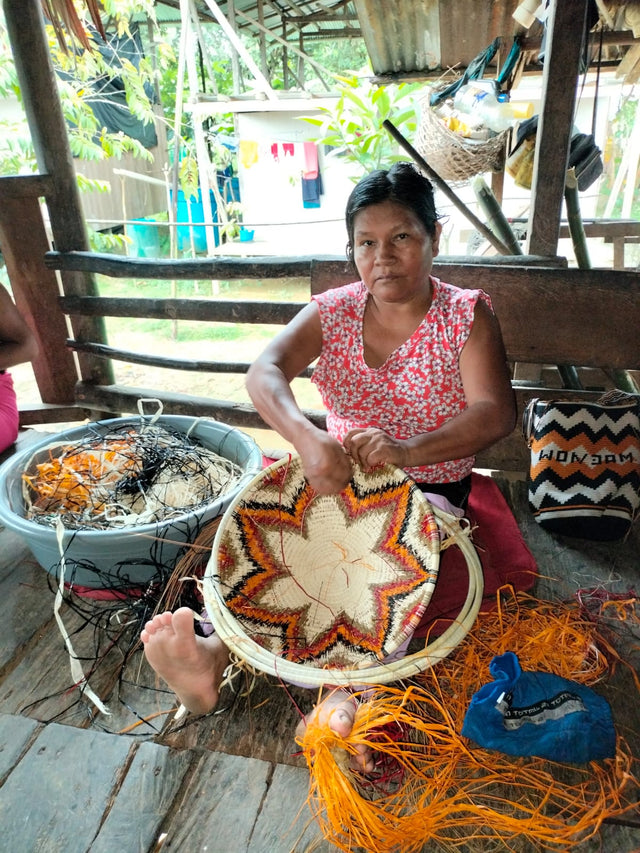


White Lines & Triangles
Columns of red and orange decorations are separated by a thin white line. This piece from the Colombian Wounaan shows thicker coils resulting in bigger, broader designs and an overall heavier basket.
Geometric motifs draw their inspiration from multiple sources, including pre-Colombian textiles, ceramics and rock art. Baskets woven with these designs are often referred to as cultural, due to the fact that a large part of their inspiration stems from body paintings and patterns.
The Colombian Wounaan primarily weave with fibers from the werregue palm, a native plant found in the rainforests of the Chocó region. The werregue palm fibers are highly durable, flexible, and resilient, making them ideal for intricate weaving. Weavers use natural dyes to color the fibers, creating rich hues that add vibrancy to their pieces. Most recently, weavers have been adding copper and silver wire to their creations.
9" W x 12" H, by a Wounaan Master Weaver.
Made from the fibers of the Werregue palm, these baskets embody a sustainable approach: young leaves are carefully harvested from the rainforest and treated to enhance their durability for weaving.
The vibrant colors are sourced from natural, local dyes—rich reds from achiote seeds, deep blacks from jagua fruit, and warm yellows from turmeric roots—resulting in a striking yet earthy palette that mirrors the surrounding ecosystem.
A group of weavers, who have been run out of their villages by drug traffickers, are now living as refugees in a new community in Bogota. These weavers have access to different materials, and have added copper wire to their designs for a new bright look. Learn more about Werregue weavers.
Stitched over many months and years from natural fibers and organic dyes, your handmade woven art should be displayed proudly, away from any windows and skylights. The ultra-violet rays of direct sun and strong light can cause the saturated natural dyes in textile and fiber art to fade, and can even damage the fibers themselves.
If your woven art resides with you in the desert or other dry environments, you may feel better occasionally misting it (as often done to wicker or rattan) inside with distilled or non-chlorinated tap water. Using a paper towel, gently pat any excess moisture from the interior.
From the most diminutive baskets, scarcely larger than a thimble, to magnificent creations spanning three feet in width, painstakingly crafted over the course of eight years, RFB proudly imports an expansive range of woven masterpieces.
In collaboration with our esteemed local partners, we undertake extensive journeys to personally engage with weavers. These voyages involve meticulous inspections of works in progress, as well as the evaluation of recently finished pieces prepared for shipment.
displaced by violence
Maintaining culture as refugees

using natural resources
colors sourced from natural, local dyes

urban and rural
Weavers from villages and cities

Be In-The-Know
Be the first to know about new collections and exclusive offers, and get 30% off your first purchase.
Shipping
Shipping is free within the continental United States. We ship by USPS First Class and Priority, and UPS Ground
Returns
We will be happy to offer a full refund (excluding shipping) on items returned within 7 days of receipt of delivery
Tradeup
Looking at a new piece but already have a piece in that spot? You can Trade Up your current art for a new piece of equal or more value.
RFB Woven Art
Passionate custodians of tradition.

